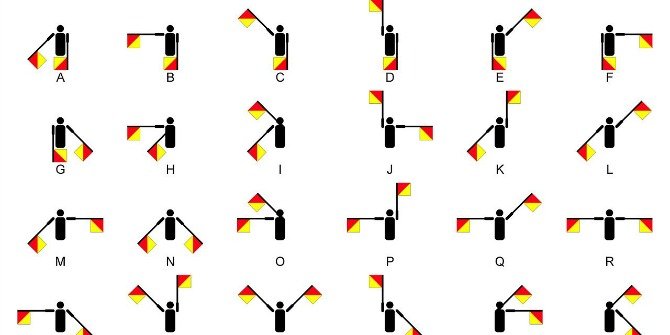2827: Peace Symbol ☮ Sep 16, 2024
The peace symbol, ☮, known also as the CND symbol, was made for the Campaign for Nuclear Disarmament, but even its creator did not give a single, clear answer after it was first displayed in 1958 to protest outside of the Nuclear Weapons Research Center in London. While he said that the symbol was supposed to be reminiscent of someone kneeling with his arms outstretched, his original explanation is that it comes from flag semaphore, specifically from the overlap of signals of someone making an N and a D, for “nuclear disarmament”. Ultimately, even if it was abstracted, that would possibly make this one of the last major uses of flag semaphore for any vaguely communicative or at least symbolic purpose in modern life.
2661: Japanese Semaphore Mar 31, 2022
Things like semaphore and morse code word for alphabetic systems like the Latin alphabet, but it might not be obvious how Japanese writing might be adapted for it. Japanese semaphore for instance had to rethink the concept since there are about twice the number of characters compared to the Latin alphabet, and it is a syllabary. Instead, with a red flag in the right hand and white in the left, they had the semaphore signals roughly match the trajectory of how the strokes look in the characters but this would usually take two or more different motions complete. Semaphore already rotated the flags like the hands of a clock to sign letters and numbers with the same displays, owing to its clock-like mechanical origins, but Japanese semaphore had a different system for numbers to its letters.
2660: Origins of Semaphore Mar 30, 2022
Although the idea of having a system of flag-signals to represent letters for use on ships or other long-distance scenarios might seem both vital and basic, the modern semaphore system only came about in 1866. This followed the telegraph system and the optical telegraph. While the optical telegraph was useful for shore-to-ship signalling as it was a large structure and could use long mechanical arms to do so, but on ships this was impractical so people signalled with their hands, often holding flags for visual clarity. That said, by the time semaphore was introduced formally, the optical telegraph was out of use, replaced with the electric telegraph.
2659: Optical Telegraph Mar 29, 2022
Before the advent of radio, and even the electric telegraph, there was still a need to transmit specific messages short-distance, especially without the use of cables. This was particularly needed with ships, and while a lighthouse can be useful sometimes, another machine called the optical telegraph was invented. At night, a so-called shutter telegraph use panels to precisely block light in order to transmit a message in code, but during the day, semaphore telegraphs would use long mechanical arms to indicate the different letters. Some could be used to transmit messages up to 20 miles with a telescope and good weather conditions, not only to ships but to other relaying post towers. These machines were not in use very long, but they did inspire the use of other developments that followed shortly.

